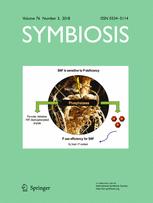Ver ítem
- xmlui.general.dspace_homeCentros e Institutos de InvestigaciónCIAP. Centro de Investigaciones AgropecuariasInstituto de Fisiología y Recursos Genéticos VegetalesArtículos científicosxmlui.ArtifactBrowser.ItemViewer.trail
- Inicio
- Centros e Institutos de Investigación
- CIAP. Centro de Investigaciones Agropecuarias
- Instituto de Fisiología y Recursos Genéticos Vegetales
- Artículos científicos
- Ver ítem
Polyamines and flavonoids : key compounds in mycorrhizal colonization of improved and unimproved soybean genotypes
Resumen
Modern breeding programs might have caused a reduction in plant responsiveness to arbuscular mycorrhizal fungi (AMF). Flavonoids and polyamines (PAs) are hypothesized to play a role in this symbiosis. We tested the effects of them in AMF roots of improved (I-1) and unimproved (UI-4) soybean genotypes, under the hypothesis that domestication decreased their concentration in roots, affecting AMF colonization, particularly arbuscule formation. After 20 days
[ver mas...]
Modern breeding programs might have caused a reduction in plant responsiveness to arbuscular mycorrhizal fungi (AMF). Flavonoids and polyamines (PAs) are hypothesized to play a role in this symbiosis. We tested the effects of them in AMF roots of improved (I-1) and unimproved (UI-4) soybean genotypes, under the hypothesis that domestication decreased their concentration in roots, affecting AMF colonization, particularly arbuscule formation. After 20 days of treatment, AMF roots of UI-4 genotype had greater amount of total flavonoids/phenols and PAs while in I-1 genotype no differences were observed between roots of mycorrhizal (M) and non mycorrhizal (NM) plants. Exogenous application of flavonoids led to an increase in arbuscules in both genotypes. Improved-1 genotype needed higher levels of flavonoids to reach the percentage of mycorrhization achieved by UI-4 control. In regard to PAs, mycorrhizal plants of both genotypes had higher endogenous concentration than NM plants, however, the highest concentration, especially of putrescine (put) was in UI-4 M genotype. To check the participation of put in symbiosis we used RNAi silencing methodology. Down regulation of the GmADC transcript, involved in put formation, had a profound negative effect on mycorrhizal colonization and also affected the normal development of the plant. By contrast, down regulation of GmDAO, in which ADC transcript was expressed, arbuscule formation was similar to control plant. Our results suggest that mycorrhizal colonization is affected by soybean domestication particularly arbuscule formation and this effect seems to be mediated by the endogenous roots levels of flavonoids and PAs, especially put.
[Cerrar]

Autor
Salloum, María Soraya;
Menduni, Maria Florencia;
Benavides, María Patricia;
Larrauri, Mariana;
Luna, Celina Mercedes;
Silvente, Sonia Teresa;
Fuente
Symbiosis 76 (3) : 265–275. (November 2018)
Fecha
2018-11
Editorial
Springer
ISSN
0334-5114
1878-7665 (Online)
1878-7665 (Online)
Formato
pdf
Tipo de documento
artículo
Palabras Claves
Derechos de acceso
Restringido
 Excepto donde se diga explicitamente, este item se publica bajo la siguiente descripción: Creative Commons Attribution-NonCommercial-ShareAlike 2.5 Unported (CC BY-NC-SA 2.5)
Excepto donde se diga explicitamente, este item se publica bajo la siguiente descripción: Creative Commons Attribution-NonCommercial-ShareAlike 2.5 Unported (CC BY-NC-SA 2.5)

